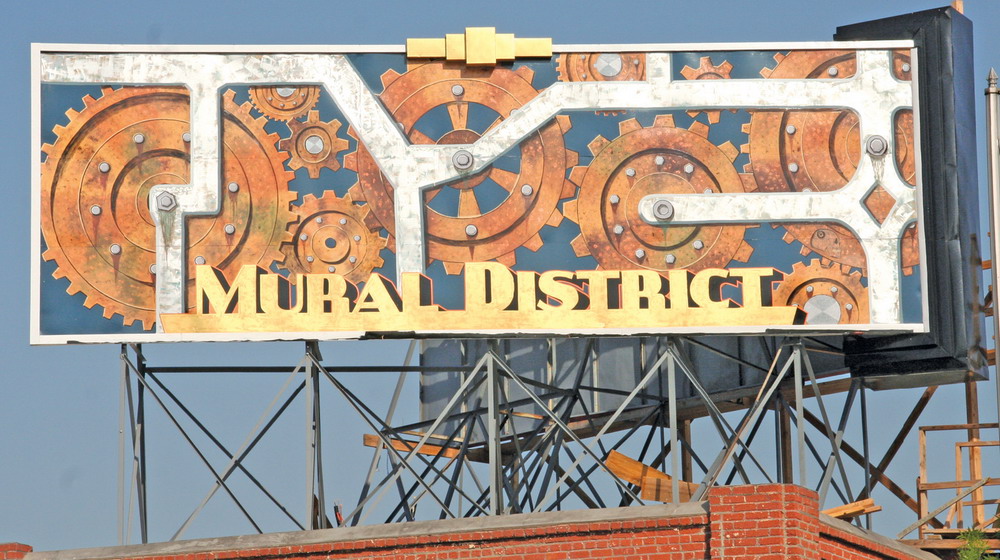Design
The Mural of the Story
Published
13 years agoon

FranCisco Vargas, formerly known as the Travelling Millennium Sign Artist, is a Fresno, CA-based muralist who owns his own shop, Studio Vargas.
During the last decade, downtown Fresno has enjoyed a cultural revival. Reza Assemi, an artist turned developer, has spearheaded the development of the city’s Mural District, an enclave that covers approximately 20 blocks from Tuolumne St. to E. Divisadero St. It features several galleries, studios and other artistically oriented businesses – and, of course, several, building-exterior murals that make the neighborhood a public-art treasure trove.
After a bid process, Assemi hired me to paint a billboard that would identify the district. Fortunately, Fresno’s sign and building codes don’t require permits for murals. The billboard, which measures 10 x 30 ft., presented a moderate challenge because of its location on a slanted roof atop wooden, handmade scaffolding. I quickly noticed a few weak spots and open areas. Pieces of scaffolding planks were missing, and its ends were very loose.
Assemi’s company fixed the problem quickly. The solution was something new to me – pump jacks, which provide a platform that can be adjusted by moveable brackets on vertical poles. I’d never used them, but I know other muralists and painters who have and liked them. The pump jacks were mounted on 2 x 4s, which were sufficient for me to reach the top of the billboards when I added another plank.
Originally, the mural was supposed to feature an art-deco scene. But, Assemi switched the theme to gears because of this area in downtown Fresno. Decades ago, the area had been a major industrial district, and he thought gears would provide a fitting tribute to the community’s heritage. I’d never painted gears on a mural, but with an Internet search, I researched different gear designs and created a template that Assemi ultimately approved for the billboard.
Advertisement
Preparation makes perfect
Assemi was more hands-on with this project than most clients. As a former artist, he wanted to experience working up on the catwalk and using different types of paints than he’d used in his career as a fine artist. Assemi thoroughly enjoyed working on the billboard.
The billboard had new, metal sheets that had been mounted in place when the scaffolding was installed. I didn’t know if the metal had been primed. Although it appeared to be, I don’t like to take chances. Preparation is one of the most important facets of painting a good-quality mural.
I wiped the billboard down with lacquer thinner, then used an oil-based primer. I don’t recall the brand for sure, but I think it was Kilz. I knew most of the colors would feature earth tones, so I used a tan color for the basecoat. Melody Berlinski and I painted the base coat; we used 9-in., foam rollers from Ace Hardware.
Sometimes, I can use a projector to convey the image onto the surface. However, because of the slanted roof and all the wood framing in the way, a projection couldn’t happen. I also wasn’t able to use my “baby,” a 1970 Ford ladder truck with a 30-ft. reach, to paint the billboard. I used it to get to the roof ledge and climbed an extension ladder to get to the scaffolding catwalk. I used my skills to create a scale drawing. It takes a little longer to work by scale, instead of with a projection, because it requires extra time to figure exact proportions.
AdvertisementAfter the layout was completed, we started painting the gears and filling in areas with 1Shot lettering enamels. Four or five days into the project, Berlinksi left town to attend to a family emergency. However, I persevered and completed the project in approximately three weeks.
A master’s techniques
To create the gears’ blending effects, I used boiled linseed oil and Smith’s cream. The boiled linseed oil slows the drying process, and the Smith’s cream helps it flow and blend better while providing a thicker consistency. I wrapped plastic bags around the rags to create a ball shape, which worked like a large pounce bag. I painted the Smith’s cream on the metal, rolled on the paint, and then start to mix my colors to create my effects using angular, soft-haired, fitch brushes and rags.
Sections of the mural feature splatter effects. I handled this by dipping the brush into the paint, holding my fingers on the bristles and flicking it back to leave specks. I asked Assemi about creating a rust faux-finish on the gears to suggest aging effects. With his OK, l covered the bolts with rust stains that drip down the gears, using a paint thinner-filled spray bottle, which I let drip the color across the mural’s face like a rust stain.
I painted the metallic-colored components that hold the gears with bevels in different shades of light blues and grays with random, foam-roller strokes of 1Shot metallic-silver paint. Given their abundant exposure to bright sunlight, these areas practically begged for silver-tinted streaks. For other shaded elements, I used 1Shot tinting clear, mixed with a little black and brown lettering enamel, which created translucent shadows. I didn’t use an exact ratio, but, in a 3-oz. cup filled with thinner, I dipped a small dab of enamel on a stir stick and stirred. For a more translucent look, use less enamel; for a more opaque effect, use more.
AdvertisementTo create the text, I applied a metallic-gold base and created a similar effect on the letters using random strokes of 1Shot metallic-brass paint. Metallic-copper 1Shot forms a distinctive outline.
When you’re working outside on a sign, many different, often a little crazy, thoughts flow through your mind. Personally, I usually listen to music, and I always think about what it would be like to dance on the plank where I sit or stand on during the job. I feel pretty balanced walking on a 9-in.-wide plank – sometimes, even backwards. In my experience, doing “walldog” work always makes me feel like I’m on stage because crowds always gather. One particular song, Sade’s “Paradise,” somehow always gets me in the mood to dance.
A good friend of mine, Ramiro Martinez, shot a video of me at work (and grooving with Sade). To check out my moves (and see a close-up video of me painting the mural), go to www.youtube.com/watch?v=l1nVKf5_JOo&feature=fvsr.
Equipment and Materials
Coatings: Oil-based primer, from Kilz (Imperial, MO), (800) 325-3552 or www.kilz.com; 1Shot® Lettering enamels, from One Shot LLC (Chicago), (773) 646-2778 or www.1shot.com; Linseed oil and Smith’s cream, available from art-supply stores; paint thinner, from home-improvement stores; and 1Shot tinting clear, from One Shot LLC.
Tools: Nine-in., foam roller brushes, from Ace Hardware and other home-improvement stores; fitch brushes, available from art- and painting-supply stores; and pump jacks, available from building-supply and paint-supply houses.
More About FranCisco
FranCisco Vargas was born in Yakima, WA, but moved around frequently with his parents before they ultimately settled in Fresno, where he began working at the age of 11 shining shoes and picking crops on local farms. Vargas began painting signs in a small shop as a teenager, and he studied the craft at a Los Angeles vocational school. He set up his first signshop in the backyard of his San Jose, CA home.
He credits creating a mural for Garfield’s, a San Jose nightclub, as providing his big break (the job won him an award in ST’s 1984 Commercial Sign Design Contest). Since then, his booming career has provided him such diverse projects as creating banners for the Fresno Autorama show, a commission to create a Playboy Centerfold poster and related showcards. In 1998, he set off on a cross-country tour as “The Travelling Millennium Sign Artist.” He painted murals and signs from Fresno to Key West, FL.
For more information about FranCisco and his shop, visit www.franciscovargas.com.
SPONSORED VIDEO
Introducing the Sign Industry Podcast
The Sign Industry Podcast is a platform for every sign person out there — from the old-timers who bent neon and hand-lettered boats to those venturing into new technologies — we want to get their stories out for everyone to hear. Come join us and listen to stories, learn tricks or techniques, and get insights of what’s to come. We are the world’s second oldest profession. The folks who started the world’s oldest profession needed a sign.
You may like
Advertisement
Subscribe

Magazine
Get the most important news
and business ideas from Signsofthetimes Magazine.
Advertisement
Most Popular
-

 Tip Sheet3 days ago
Tip Sheet3 days agoAlways Brand Yourself and Wear Fewer Hats — Two of April’s Sign Tips
-

 Business Management1 week ago
Business Management1 week agoWhen Should Sign Companies Hire Salespeople or Fire Customers?
-

 Women in Signs2 weeks ago
Women in Signs2 weeks ago2024 Women in Signs Award Winners Excel in Diverse Roles
-

 Real Deal4 days ago
Real Deal4 days agoA Woman Sign Company Owner Confronts a Sexist Wholesaler
-

 Editor's Note1 week ago
Editor's Note1 week agoWhy We Still Need the Women in Signs Award
-

 Line Time2 weeks ago
Line Time2 weeks agoOne Less Thing to Do for Sign Customers
-

 Product Buying + Technology1 week ago
Product Buying + Technology1 week agoADA Signs and More Uses for Engraving Machines
-

 Women in Signs4 days ago
Women in Signs4 days ago2024 Women in Signs: Megan Bradley










